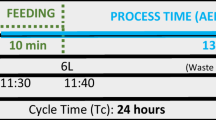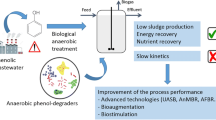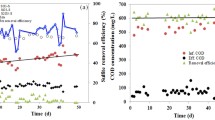Abstract
Aerobic and anaerobic biodegradation of six priority PCBs was investigated in continuous stirred tank reactors fed with naturally contaminated sewage sludge. Anaerobic and aerobic abiotic losses were higher for the lightly chlorinated PCBs but remained for all PCBs below 20%. Under strict methanogenic conditions, PCB removals were about 40% whatever PCB molecular weight or their degree of chlorination. However, considering abiotic losses, the heaviest PCBs were more efficiently anaerobically biodegraded probably because of higher dechlorination rates. The aerating sludge process enhanced removal of the lightest chlorinated PCBs from 40% up to 100%, while removal rates of the heaviest PCBs remained around 40%. Although the mesophilic aerobic process exhibits better removal efficiencies because of operating conditions, the results suggest that PCB biodegradation was strongly limited by their bioavailability in naturally contaminated sludge, under both redox conditions. Indeed, since PCB removal was closely linked to the solid reduction rates, PCB bioavailability was likely the limiting factor for biodegradation. As a consequence, the raw PCB concentrations (in mg kg–1dry weight) which are concerned by legislative procedures did not decrease sufficiently in both processes to reach a limit value fulfilling the current French/European regulation about PCB contents in sewage sludge before spreading on agricultural land.
Similar content being viewed by others
References
DA Abramowicz (1990) ArticleTitleAerobic and anaerobic biodegradation of PCBs: a review Crit. Rev. Biotechnol. 10 241–251 Occurrence Handle1:CAS:528:DyaK3MXhtFyisbk%3D
P Adriaens DD Focht (1990) ArticleTitleContinuous coculture degradation of selected polychlorinated biphenyl congeners by Acinetobacter spp. in an anaerobic reactor system Environ. Sci. Technol. 24 1042–1049 Occurrence Handle10.1021/es00077a015 Occurrence Handle1:CAS:528:DyaK3cXktFWmur4%3D
M Alexander (1981) ArticleTitleBiodegradation of chemicals of environmental concern Science 211 132–138 Occurrence Handle1:CAS:528:DyaL3MXlvFSnuw%3D%3D
Anid PJ, Nies L & Vogel TM (1991) Sequential anaerobicaerobic biodegradation of PCBs in the river model. In: Butteworth-Heinemann (Ed) On-site Bioreclamation, (pp 428–436), Oxford
DL Bedard ML Haberl RJ May J Brennan (1987) ArticleTitleEvidence for novel mechanisms of polyclorinated biphenyl metabolism in Alcaligenes eutrophus H850 Appl. Environ. Microbiol. 53 1103–1112 Occurrence Handle1:CAS:528:DyaL2sXktF2js7o%3D
DL Bedard JF Quensen SuffixIII (1995) Microbial reductive dechlorination of polychlorinated biphenyls LY Young CE Cerniglia (Eds) Microbial Transformation and Degradation of Toxic Organic Chemicals Wiley-Liss Inc New York
JF Brown RE Wagner DL Bedard MJ Brennan JC Carnahan TJ May RJ Tofflemire (1984) ArticleTitlePCB transformations in upper Hudson sediments Northeast. Environ. Sci. 3 167–179 Occurrence Handle1:CAS:528:DyaL2MXit1GltL8%3D
B Camara C Herrera M Gonzalez E Couve B Hofer M Seeger (2004) ArticleTitleFrom PCBs to highly toxic metabolites by the biphenyl pathway Environ. Microbiol. 6 842–850 Occurrence Handle10.1111/j.1462-2920.2004.00630.x Occurrence Handle1:CAS:528:DC%2BD2cXntVKisb0%3D
BV Chang SW Chou SY Yuan (1999) ArticleTitleMicrobial dechlorination of polychlorinated biphenyls in anaerobic sewage sludge Chemosphere 39 45–54 Occurrence Handle1:CAS:528:DyaK1MXjs12gu70%3D
GR Chaudhry S Chapalamadugu (1991) ArticleTitleBiodegradation of halogenated organic compounds Microbiol. Rev. 55 59–79 Occurrence Handle1:CAS:528:DyaK3MXktVCkt7c%3D
Clesceri LS, Franson MAH, Greenberg AE & Trussell RR (1985) Standard Methods for the Examination of Water and Wastewater. 16th edn. American Public Health Association. ISSN 8755-3546
E Deziel G Paquette R Villemur F Lepine JG Bisaillon (1996) ArticleTitleBiosurfactant production by a soil Pseudomonas strain growing on polycyclic aromatic hydrocarbons Appl. Environ. Microbiol. 62 1908–1912 Occurrence Handle1:CAS:528:DyaK28XjtlGhu7c%3D
LCM Hartkamp-Commandeur J Gerritse HAJ Govers JR Parsons (1996) ArticleTitleReductive dehalogenation of polychlorinated biphenyls by anaerobic microorganisms enriched from dutch sediments Chemosphere 32 1275–1286 Occurrence Handle10.1016/0045-6535(96)00039-2 Occurrence Handle1:CAS:528:DyaK28XisVaqsbs%3D
V Lang (1992) ArticleTitlePolychlorinated biphenyls in the environment J. Chromatogr. 595 1–43 Occurrence Handle10.1016/0021-9673(92)85144-I Occurrence Handle1:CAS:528:DyaK38Xhsl2qu7k%3D
WW Mohn JM Tiedje (1992) ArticleTitleMicrobial reductive dehalogenation Microbiol. Rev. 56 482–507 Occurrence Handle1:CAS:528:DyaK3sXjsFCkuw%3D%3D
G Mukerjee-Dhar T Hatta M Shimura K Kimbara (1998) ArticleTitleAnalysis of changes in congener selectivity during PCB degradation by Burkholderia sp. strain TSN101 with increasing concentrations of PCB and characterization of the bph BCD genes and gene products Arch. Microbiol. 169 61–70 Occurrence Handle1:CAS:528:DyaK1cXks1Cqug%3D%3D
MR Natarajan WM Wu R Sanford MK Jain (1999) ArticleTitleDegradation of biphenyl by methanogenic microbial consortium Biotechnol. Lett. 21 741–745 Occurrence Handle10.1023/A:1005586926683 Occurrence Handle1:CAS:528:DyaK1MXms1Oitbc%3D
WJ Ng JY Hu SL Ong MA Aziz (1999) ArticleTitleEffect of acidogenic stage on aerobic toxic organic removal J. Environ. Eng. 125 495–500 Occurrence Handle1:CAS:528:DyaK1MXjtlaiurs%3D
H Przyrembel B Heinrich-Hirsch B Vieth (2000) ArticleTitleExposition to PCBs and health effects of residues in human milk Adv. Exp. Med. Biol. 478 307–25 Occurrence Handle1:CAS:528:DC%2BD3MXktlCnuro%3D
JF Quensen SuffixIII JM Tiedje SA Boyd (1988) ArticleTitleReductive dechlorination of polychlororinated biphenyls by anaerobic microorganisms from sediments Science 242 752–754 Occurrence Handle1:CAS:528:DyaL1MXlt1Cnsw%3D%3D
JF Quensen SuffixIII SA Boyd JM Tiedje (1990) ArticleTitleDechlorination of four commercial polychlorinated biphenyl mixtures (Aroclors) by anaerobic microorganisms from sediments Appl. Environ. Microbiol. 56 2360–2369 Occurrence Handle1:CAS:528:DyaK3cXlsVKrtLg%3D
Ross WR, Novella PH, Pitt AJ, Lund P, Thomson BA, King PB & Fawcett KS (1992) Anaerobic digestion of wastewater sludge: operating guide Project No. 390. Report to the Water Research Commission of Pretoria South Africa
Z Shi (1998) ArticleTitleBiodegradation of UV-irradiated polychlorinated biphenyls in surfactant micelles Wat. Sci.Technol. 38 25–32 Occurrence Handle10.1016/S0273-1223(98)00603-9 Occurrence Handle1:CAS:528:DyaK1MXjtVWitg%3D%3D
E Trably D Patureau JP Delgenès (2003) ArticleTitleEnhancement of Polycyclic Aromatic Hydrocarbons (PAHs) removal during anaerobic treatment of urban sludge Wat. Sci. Technol. 48 53–60 Occurrence Handle1:CAS:528:DC%2BD3sXovV2nsL4%3D
E Trably N Delgenès D Patureau JP Delgenès (2004) ArticleTitleOptimization and validation of a highly reproducible method for Polycyclic Aromatic Hydrocarbons (PAHs) analysis in sludge samples Int. J. Environ. Anal. Chem. 84 995–1008 Occurrence Handle10.1080/03067310412331298412 Occurrence Handle1:CAS:528:DC%2BD2cXhtVejurzI
E Trably D Patureau JP Delgenès (2005) Comparison of Polycyclic Aromatic Hydrocarbons (PAHs) removals during anaerobic and aerobic sewage sludge treatment E Lichtfouse S Dudd D Robert (Eds) Environmental Chemistry Springer-Verlag Heidelberg, Germany
Water Agency (1994) Urban Networks: Current Techniques of Treatment and Evolution. Inter-agencies Study No. 27. Ed. French water agency
Q Wu KR Sowers HD May (1998) ArticleTitleMicrobial reductive dechlorination of aroclor 1260 in anaerobic slurries of estuarine sediments Appl. Environ. Microbiol. 64 1052–1058 Occurrence Handle1:CAS:528:DyaK1cXhs1artLo%3D
Y Zhang WJ Maier RM Miller (1997) ArticleTitleEffect of rhamnolipids on the dissolution, bioavailability, and biodegradation of Phenanthrene Environ. Sci. Technol. 31 2211–2217 Occurrence Handle1:CAS:528:DyaK2sXjvFCrtL0%3D
Author information
Authors and Affiliations
Corresponding author
Rights and permissions
About this article
Cite this article
Patureau, D., Trably, E. Impact of Anaerobic and Aerobic Processes on PolyChloroBiphenyl Removal in Contaminated Sewage Sludge. Biodegradation 17, 9–17 (2006). https://doi.org/10.1007/s10532-005-1920-4
Accepted:
Issue Date:
DOI: https://doi.org/10.1007/s10532-005-1920-4




